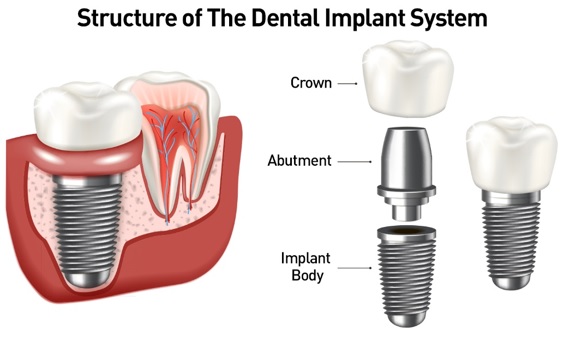Dental Implants Fundamentals Explained
Dental Implants Fundamentals Explained
Blog Article
A Biased View of Dental Implants
Table of ContentsDental Implants Fundamentals ExplainedDental Implants for DummiesThe 25-Second Trick For Dental ImplantsOur Dental Implants PDFs
are clinical devices operatively implanted right into the jaw to restore a person's capacity to eat or their appearance. They supply assistance for synthetic (phony) teeth, such as crowns, bridges, or dentures. When a tooth is shed because of injury or condition, an individual can experience issues such as quick bone loss, defective speech, or modifications to eating patterns that result in discomfort.
Structure of The Oral Implant System selecting oral implants, speak to your dental company about the potential advantages and risks, and whether you are a prospect for the procedure. Points to think about: Your overall health is a vital aspect in identifying whether you are a good prospect for dental implants, how long it will certainly take to recover, and exactly how long the dental implant might remain in place.
Smoking cigarettes might affect the healing procedure and reduce the lasting success of the implant. The healing procedure for the implant body may take a number of months or longer, throughout which time you usually have a momentary joint instead of the tooth. the oral implant treatment: Very carefully follow the dental hygiene guidelines offered to you by your oral supplier.
An Unbiased View of Dental Implants
Implant failing can cause the demand for another surgery to take care of or change the dental implant system. Recovers the capacity to eat Recovers aesthetic look Aids keep the jawbone from shrinking due to bone loss Protects the health of the surrounding bone and periodontals Assists keep nearby (close-by) teeth secure Boosts lifestyle Damage to bordering all-natural teeth throughout dental implant positioning Injury to the surrounding tissues throughout surgery, such as sinus perforation Injury throughout surgical treatment (for instance, fracture of bordering jawbone) Poor feature, such as seeming like the teeth do not bite together normally An experience that the tooth is loosened or twisting in area arising from a joint screw loosening Implant body failure (looseness of the dental implant body) because of systemic infection, which may be more probable in people with unrestrained diabetics issues because of local infection in bone and gums supporting the implant body as a result of postponed healing, which may be more likely in people that smoke Trouble cleansing the gum tissues around the dental implant, leading to bad dental health Unattended gum condition Post-surgical numbness due to nerve impingement or damages Always inform health care providers and imaging professionals that you have dental implants prior to any magnetic vibration imaging (MRI) or x-ray treatments.
FDA is not knowledgeable about any damaging events reported for MRI or x-ray treatments with dental implants. Oral implants systems are generally constructed from materials that comply with international consensus standards of the International Organization for Standardization (ISO) or ASTM International. These criteria have information of what makes a risk-free material.
Various other products such as gold alloys, cobalt-based alloys, titanium alloys, or ceramic products are sometimes utilized. The safety and security accounts of these materials are well-known. Dental dental implant systems are reviewed according to international consensus requirements. Biocompatibility screening, to reveal that physical call with the tool does not cause complications like inflammation or sensitive response, belongs to the analysis that helps ensure the materials in the dental implant system are risk-free and do not create damaging effects when implanted in individuals.

See This Report on Dental Implants
Some individuals are not eligible for dental implant surgery. It is for dental doctors to operate people with: intense illnessuncontrollable metabolic diseasebone or soft cells disease or infectionIf these concerns are settled, an individual can have the surgical procedure. Dental Implants. In, dental specialists abstain from running on individuals with: If individuals with any one of the above go through dental implant surgical procedure, there is a greater danger of the dental implant falling short
Some people have a jawbone abnormality that prevents enough bone for an implant from establishing. In such situations, a doctor might require to execute a ridge adjustment. This involves raising the periodontal to subject the area of flawed bone. The doctor will certainly then use a bone or bone replacement to fix and develop up the area.
Dental dental implant surgical procedure is a personalized procedure. It's not the exact same for everyone. The complying with gives a basic overview of what you can anticipate your dental professional, dental cosmetic surgeon, periodontist or prosthodontist to do: Place the dental implant surgically. Offer you time to heal. Affix the message and last crown, bridge or denture.
Next off, your cosmetic surgeon will very carefully position the oral implant into your jaw. If your implant is near the front of your mouth, your dental expert will certainly make a short-lived tooth for you to wear until you heal.
The Dental Implants Diaries
Your provider can tell you what to expect in your scenario. Throughout the healing phase, your jawbone needs to fuse to the oral implant. This procedure, called osseointegration, is critical for security and lasting success. This procedure can take anywhere from three to nine months. In many cases, it may take longer.
When useful source your implant heals, your dental practitioner can attach the joint (tiny port message) and your last reconstruction (crown, bridge or denture). This usually takes concerning one hour to finish and may call for a second minor surgery. You should not feel any discomfort during your dental implant procedure because your service provider will certainly utilize medicine to numb your gums.
Report this page